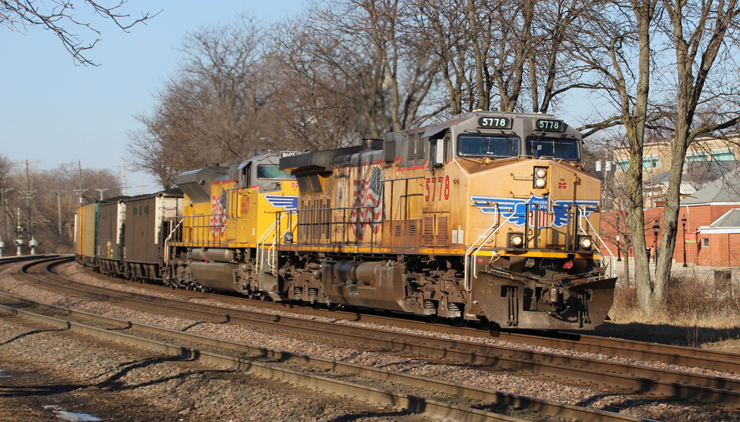OMAHA, Neb. – A resurgence in railroad traffic will hinge in part on how consumer spending rebounds as the economy emerges from pandemic-related restrictions, Union Pacific CEO Lance Fritz says.
Rail traffic depends on global trade, North American industrial production, and consumer spending, Fritz told an investor webcast on Wednesday.
Fritz says consumer demand remains the most puzzling element of the three. Some people can’t wait to get out of the house and spend their money, he says, while others won’t go out until they feel safe about their health. “I think consumers are all over in between those two goalposts,” Fritz says.
Local communities and businesses can play an important role by helping people feel safe and support a return to more normal levels of consumer spending, Fritz says.
After April’s historic volume declines, UP’s traffic has stabilized at around 23% below the levels of last year, which is in line with the railroad’s expectations for a second-quarter decline of around 25%. “It looks like we’ve got our feet back under ourselves again and we’re doing just great work on the service product and on efficiency,” Fritz says.
UP’s bulk business is off 19% for the quarter, led by declines in coal, as well as shipments of frozen and refrigerated products such as beer. Grain, however, is up about 8%, Fritz says. “I think that’s early returns on China getting back into the market for export grain, which is very welcome,” Fritz says.
Industrial products shipments are down about 16%, Fritz says, due largely to the impact of low crude oil prices that have slowed U.S. oil production and the need for frac sand, steel pipe, and chemicals used in drilling.
Premium volume, which includes intermodal and automotive, is down 30% due to reduced consumer demand and the shutdown of North American auto assembly plants for several weeks.
To cut costs as volume declined sharply due to the pandemic, UP furloughed train crews and shop forces, ordered management staff to take one unpaid week off each month through August, and had executives take a 25% pay cut.
UP will review the management pay cuts in July or August and will resume shop operations in North Little Rock, Ark.; DeSoto, Mo.; and Denver once volume bounces back. “Nothing would please me more than to have those temporary activities end and end quickly because we’re seeing volume come back,” Fritz says.
Fritz says the combination of lower costs and service improvements under Unified Plan 2020, its version of Precision Scheduled Railroading, is enabling UP to better compete for new business.
Fritz says UP has converted some highway business back to rail, including specialty grains, food, some manufactured products, as well as traffic to and from maquiladoras, the factories in Mexico along the U.S. border.
It’s just that those wins don’t show up in UP’s volume numbers due to the impact of the pandemic, he says.
“When the impact of COVID tones down and starts abating and going away, I have lots of confidence in our ability to get a growth dividend from what we’ve done with the network,” Fritz says.
Despite volume declines, UP continues to increase train length and is rapidly building siding capacity to handle longer trains. The railroad is adding eight new sidings and extending 34 others across the system, with most of the projects scheduled for east of El Paso, Texas, on its former Golden State, Texas & Pacific, and Sunset Routes.
Eight of the projects are complete already. “So we’re at a helluva pace,” Fritz says. “A normal year for us might be 10 or a dozen of those a year.”
He spoke at the Bernstein 36th Annual Strategic Decisions Conference.















The UP still goes out of the way to get rid of profitable business. The traffic is there but they don’t want it. I see it everyday
UP executives taking a 25 percent cut. WOW Mr Fritz will have to get by on a $9 million dollar salary as the Omaha World Herald says his annual salary is $12 million. Of course the 25% cut isn’t really for the whole year so I guess he will survive
Well said Mr Landley! If UP management had any intelligence, they would do anything and everything to pick up new business.
I would say too, business will come back if shippers desire mediocre service at a cost at or higher than trucking. I think not. The UP still is not facing reality. Longer trains, are you kidding? That means longer dwell times in a more rapid supply chain requirements.
Starting to see a few loaded auto racks moving now on the CN, hopefully a good sign but the middle class must get back to work to sustain the auto industry.
Rail resurgence may rest with UPRR being the target of a successful exorcism.
Did anyone inquire re. the Rotterdam, N.Y. perishable traffic?
J Robert Wayman, First a correction, it’s the 2%, not 1%(this has been wrong from the beginning of calling them that, it’s always been 2%). Secondly, it’s always the lower, middle and upper middle class that has lead the country economically…we spend the most money on consumer goods. As noted in the article, it depends on just how fast those people return to work and start spending again….and of those that have continued to work the entire time, how comfortable they are with spending and travel.
While some of the one per centers have money, those who have been furloughed and those who have lost their jobs don’t have the where-with-all to become consumers so I not sure what makes Union Pacific CEO Lance Fritz so positive that they will lead the rebound.